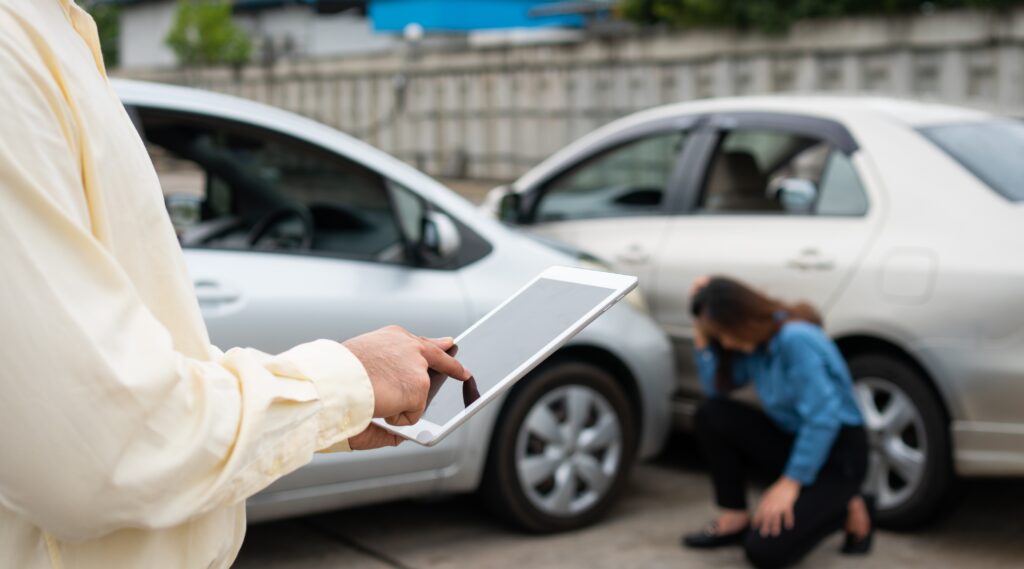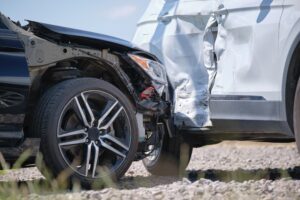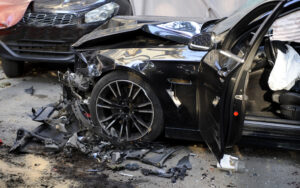
You’re passing through an intersection during a green light, and suddenly, a truck slams into the side of your car at 30 miles per hour. In an instant, you’ve become involved in a T-bone accident, also known as a broadside collision.
This type of crash occurs when the front of one vehicle strikes the side of another, often resulting in severe damage and injuries.
If you’re involved in a T-bone accident, you likely sustain injuries and experience lost earnings, pain, and suffering. You should speak to a Bakersfield car accident attorney, who can prove fault in the case and get you fair compensation.
T-Bone Accident Facts
Vehicle safety has improved dramatically in recent decades to reduce the number of T-bone accident deaths and injuries. Still, every year, T-bone accidents lead to 8,000 deaths in the U.S., and many thousands more suffer an injury. These crashes cause approximately 25 percent of all U.S. passenger vehicle occupant fatalities.
If the occupants of the struck vehicle are on the side of the collision, the chances of death escalate.
Even with safety improvements, many vehicles still lack adequate side-collision safety features to protect occupants from side-impact crashes. Children are often in the backseat, which can protect them in a frontal collision. But a T-bone accident leaves children in the backseat vulnerable.
What Causes T-Bone Accidents?
T-bone auto accidents are common, and they can be extremely dangerous. Why? First, let’s examine where T-bone accidents happen, which will partially explain why they can be so serious:
Four-Way Intersection
A driver entering the intersection going west at the same time that another driver entering the intersection going north hits each other, most likely because one driver didn’t obey the stop sign or traffic light. A four-way intersection T-bone accident may happen when one driver tries to beat the light.
Turning Left Across Traffic
A driver attempts to turn left across traffic, but simultaneously, another driver enters the intersection going straight. The car goes straight and hits the car, turning left.
This type of T-bone accident usually occurs when the driver turning left misjudges the speed of an oncoming vehicle or doesn’t see it at all. A left-turn accident may also occur when one driver runs a red light and hits another.
Pulling Out of a Parking Space
 A driver pulls out of a parking space, and another T-bones it when going through the parking lot. These T-bone accidents are usually less serious because of the low speeds involved. Driver inattention and obstructed vision from other vehicles often cause T-bone accidents.
A driver pulls out of a parking space, and another T-bones it when going through the parking lot. These T-bone accidents are usually less serious because of the low speeds involved. Driver inattention and obstructed vision from other vehicles often cause T-bone accidents.
Other common causes of T-bone accidents are distracted driving, reckless driving, speeding, and drunk driving.
Injuries in T-bone crashes, especially in intersections, can cause:
- Broken bones
- Traumatic brain injuries
- Spinal injuries
- Internal injuries
- Joint dislocations
- Burns
Why Are T-Bone Accidents Dangerous?
T-bone crashes can be dangerous, especially at higher speeds. When your vehicle is hit from the front or rear, several feet of the vehicle—steel, the engine, the trunk, seats, etc.- protect you from the impact. Building modern vehicles so that parts absorb much of the crash impact, resulting in fewer serious injuries for occupants.
When a car T-bones you at high speed, and you are seated on the side of the impact, only the window and door are between you and the other car. Critical factors in the severity of T-bone accident injuries are the size and speed of the vehicle hitting you and the impact position related to where you are in the car.
Generally, the bigger and faster the vehicle hits the side of your car, the closer you are to the impact and the higher the chance of serious injury. In 2020 alone, more than 5,400 people died in T-bone collision accidents, which was 23 percent of all auto accident deaths that year.
Legal Options After a T-Bone Crash
After a T-bone accident, you will likely have injuries and other losses. There are several ways that you can get your losses paid for:
Medical Bills Covered by Your Health Insurance
Your health insurance policy only covers medical expenses, not pain and suffering or lost earnings. So, relying on health insurance isn’t the best bet to receive the most for your damages.
However, you can rely on your health insurance to cover most of your initial medical expenses. If another driver caused the crash, your healthcare provider will demand payment from the other party’s insurance company later.
Payment From Your Auto Insurance Company
 You can usually file a claim with your auto insurance company to cover your medical bills. But your auto insurance will probably not cover your lost earnings.
You can usually file a claim with your auto insurance company to cover your medical bills. But your auto insurance will probably not cover your lost earnings.
If you are in a no-fault state, your auto insurance may require personal injury protection (PIP) to pay for your medical bills and partially lost income.
If another driver hits you in the T-bone crash, your auto insurance company will probably seek reimbursement from the other driver’s insurance provider.
Payment From the at-Fault Driver
If the other driver was at fault in the T-bone crash, you can file a claim against them or their insurance company. If the fault is clear, their insurance company may offer you a settlement.
If the auto insurance company doesn’t offer enough compensation, you can file a lawsuit. Your attorney will try to negotiate for the most compensation in a settlement. Out-of-court settlements resolve most car accident claims.
Who Is at Fault for a T-Bone Crash?
It’s common to wonder who is at fault for a T-bone accident. After all, you need to prove that another party was at fault for you to receive compensation for your injuries.
In a T-bone crash, the driver who does not yield the right of way to the other driver typically bears fault. Crash scene evidence, such as tire marks and eyewitness statements, are often relied on to prove fault for T-bone accidents.
Most T-bone crashes blame one driver, but circumstances can arise where both drivers share fault. Overall, right-of-way violations cause most T-bone collisions. The key to most of these accidents is determining who violated the other’s right of way.
If one driver has the right of way in an intersection and hits another vehicle that should have stopped at a red light, the second driver may bear fault. Or, maybe the driver turning left has the green arrow, and an oncoming vehicle doesn’t stop and crashes into the first car. In this case, the driver going straight will bear liability for the accident.
Determining Fault for a T-Bone Crash
Determining who is at fault for the T-bone accident requires considerable evidence. Photographs, surveillance videos, eyewitness statements, tire marks on the road, vehicle damages, and the official police report will be critical in determining who pays whom.
Your car accident attorney will collect this evidence to determine fault, but you can help by taking photos and videos of the vehicles and their positions after the accident.
When law enforcement comes to the scene of the T-bone crash, the police officer may or may not determine fault. They may even incorrectly determine fault and note it in their report.
On the other hand, some accidents can have clear evidence of fault. However, you can expect eyewitnesses to have different accounts of what happened. Plus, the other driver may accuse you of causing the crash.
That’s why your case will benefit from the start with an experienced car accident attorney. Your lawyer will advocate for your rights and build the strongest case.
Filing a T-Bone Crash Claim or Lawsuit
To file a successful claim or lawsuit for a T-bone accident, you must provide some or all of the evidence mentioned earlier to prove the other driver’s fault. You also must show that you suffered an injury in the accident and have damages.
Once you have this evidence, you should speak to a personal injury attorney about your legal options. Your attorney can negotiate a settlement with the at-fault person’s insurance provider. Or, they can file a personal injury lawsuit against the at-fault driver and represent you in court.

Your attorney can take the case to trial if the other insurance company does not offer a fair settlement. However, most T-bone accident claims end in settlements.
A successful T-bone accident personal injury claim means proving another party was at fault in the crash. Doing so requires legal skill and tenacity, so your best bet is to retain an attorney to support you.
To obtain compensation for you, your attorney will need to prove:
- The at-fault driver had a duty of care to drive safely and not injure other motorists. For example, drivers are supposed to stop at stop signs and red lights.
- The at-fault driver breached their duty of care. For instance, the other driver may have turned left in front of you when you were going straight and had the right of way.
- The breach of the duty of care led to your injuries.
- You have damages, such as medical expenses and lost earnings.
Your attorney can prove negligence to secure compensation for your injuries in a settlement or lawsuit.
Remember that every state has a statute of limitations for filing lawsuits, usually two to three years for personal injury claims. Failing to file within this timeframe can result in losing your right to seek damages. Therefore, take prompt action to protect your legal rights.
Damages for T-Bone Accidents
Most side-impact auto collisions result in economic damages covered by a personal injury settlement or lawsuit.
Some of the damages you can seek if the other driver was at fault for the T-bone accident include:
- Medical expenses: You can be entitled to compensation for your past, current, and future medical bills. Determining past and current medical expenses is relatively easy, but figuring out your future medical needs is more complicated. One of the benefits of retaining an attorney is that they know how to properly determine your future medical expenses. They will work with your doctors to understand the treatments needed to get you to maximum medical improvement, or MMI.
- Lost income: Someone in a T-bone crash with serious injuries cannot work for weeks or months. You may be eligible for compensation for all of your lost work time. Your attorney will obtain your employer’s income or salary information to calculate your lost income. If you have severe injuries that will affect your income in the future, your lawyer will determine what your future lost income will be. Lost earning capacity compensation is also possible for long-term or permanent injuries.
- Pain and suffering: This form of compensation is also called non-economic damages. Your T-bone accident injuries probably cause you physical discomfort, and the treatments received may also be painful. Your attorney will rely on your medical prognosis and doctor statements to argue for the most pain and suffering compensation.
- Mental anguish: If you have serious injuries, you may be entitled to payment for the mental anguish related to your injuries and the pain you suffered.
Many T-bone accident victims find that a skilled car accident attorney can get them far more economic and non-economic damages than they can on their own.
Even when you account for the attorney’s legal fees taken from the case settlement, you still will likely have more compensation than you will have to negotiate the settlement alone.
Speak to a Car Accident Attorney Today

Mickey Fine, Car Accident Lawyer
Being injured in a T-bone accident is a serious matter. You may have broken bones, head and neck injuries, internal injuries, cuts and scrapes, etc. Trying to reach a fair settlement with the insurance company without an attorney’s assistance is a mistake.
The best auto accident lawyer possesses the skill, experience, and legal knowledge to safeguard you from exploitation during settlement negotiations.
For the best case result, speak to a car accident attorney in your area today. Most auto accident attorneys work by contingency agreement, meaning you don’t pay any legal fees unless they obtain compensation for you.
